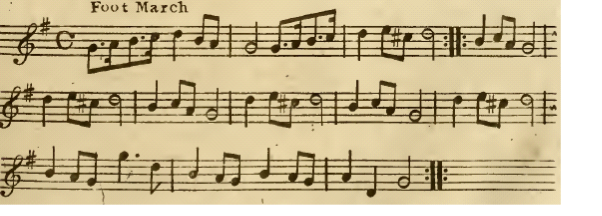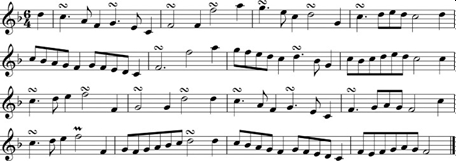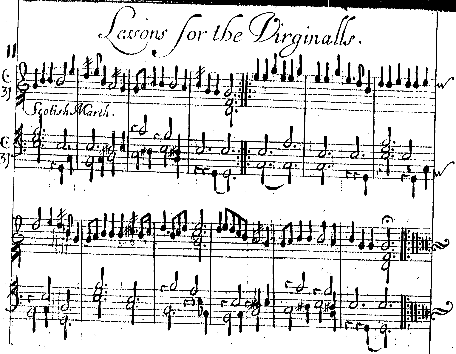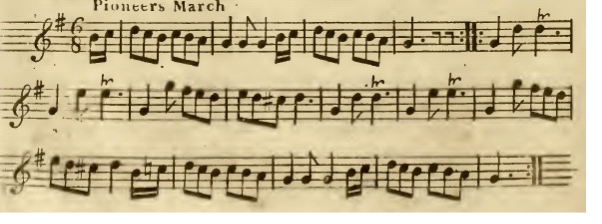The Scotch March
The first mention of the Scots March occurs in the record of Colonel Robert Monro1, concerning the Battle of Leipsigh [Leipzig; the conflict is also referred to as ‘The (first) Battle of Breitenfield] on September 7, 1631:2
“…we were masters of their Cannon, and consequently of the field, but the smoake being great, the dust being raised, we were as in a darke cloude, not seeing the halfe of our action, much lesse discerning, either the way of our enemies, or yet the rest of our Briggads; whereupon, having a drummer by me, I caused him to beate the Scots march, till it cleared up, which recollected our friends unto us, and dispersed our enemies being overcome, so that the Briggad coming together, such as were alive missed their dead and hurt Camerades”
It has been suggested that this ‘Scots March’ had been developed during the Thirty Years War [1618-1648]. However long it had been in use, by a year after Leipzig, when Monro was at ‘Donavert’ [Donauworth, in Swabia] it was clearly well-known, easily recognised and thought to strike fear into enemies who heard it. Monro made this clear in his description of an episode during the Battle at Donavert [Donauworth in Swabia], March 24, 1632:
“At which time the Chancellor Oxensterne being there in person, and Palgrave Christian Birkafield, his Excellence the Rex-chancellor caused the Dutch Regiments marching towards the enemy to beate the Scots march, thinking thereby to affright the enemy; but it fell out contrary; the Dutch that marched in the van with the Scots march, being charged by the enemy, made a base retreate till they were holden up againe by the valour of the Scots that were there.”3
Monro makes no mention of pipers in his record (apart from one ‘Murdo Piper’ who was drowned when their ship went aground4), although many Scots regiments had had pipers at least from the late 16th century: Scots Brigade records ‘Given at the Hague, the 26th June 1588’ record the appointment of Barthold Balfour as:
“captain of his compagnie colonelle of two hundred Scottish infantry, which shall include, besides his person and boy, a liutenant and ensign each with his poy [sic], two sergeants, two drummers, one piper, three corporals, one quatermaster, a surgeon, 27 musketeers, 73 arquebusiers, 63 pikemen, 18 halbardiers and three bucklers”5
and the regiment of Lord James Douglas in 1637 (formerly the regiment of John Hepburn, which in 1633 had become The First or Royal Regiment of Foot) had 96 drummers and one piper.6 Keith Sanger pointed out that in this record and others, the piper is listed before the Sergeants, and the Drummers, last.
It’s possible that these pipers were paid by their commanding officer and their duties were mostly ceremonial or for entertainment; in 1670 Sir James Turner wrote ‘In some places a piper is allowed to each company; the Germans have him [my italics], and I look upon their pipe as a Warlike Instrument. The Bag-pipe is good enough music for those who love it; but sure it is not so good as the Almain Whistle. With us any captain may keep a piper in his company and maintain him too, for no pay is allowed him, perhaps just as much as he deserveth.’7 In chapter VII of his book (‘written in the years 1670-71’) he give rates of pay for various regiments, German, French, Swedish, listed in dollars or livres, which together with the above suggests for ‘pipers’ we should perhaps read ‘fifers’. Where a regiment has only one piper, as in Douglas’s in 1637, we might assume that this is a bagpiper; elsewhere, where each company has two drummers and one piper we might perhaps, guess these are fifers [At least one contemporary comment seems to confirm this; we hope to pursue this matter further in a subsequent issue]. So much for the role of piper and drummer. The real challenge is to uncover more information about this renowned ‘Scots March’; the first thing we might conclude is that it had something very distinctive about it, that it might be a recognisable signal that the indomitable Scots were on their way. This characteristic was apparent to Samuel Pepys when, on 30th June, 1667 he met Lord George Douglas in Rochester; he mentions seeing Douglas’s Regiment (formerly John Hepburn’s, formed initially in 1625; Douglas had succeeded Hepburn as commander and the regiment became the Régiment de Dumbarton in 1675, after George Douglas was made Earl of Dumbarton). Pepys writes that
“Here in the streets, I did hear the Scotch march beat by the drums before the soldiers, which is very odde.”8 Note that Pepys makes no mention of pipers.
By the second half of the 18th century we have publications of the music appropriate to the various military commands, known as ‘The Scotch Duty’. Sir James Turner says, after telling us that ‘two drummers are universally allowed in every Company of one hundred men’ that ‘They ought to be skilful to beat a Gathering, a March, an Alarm, a Charge, a Retreat, Travaille and the Taptoo’, and this list more or less matches the contents of the ‘Duty’ as contained in Thompson’s Tutor for the Fife, published in 1765. Here is the tune given by Thompson for the ‘Foot March’ from the Scotch Duty. Thompson’s tutor, however, gives two other settings of this music, both outside the section labelled ‘Scotch Duty’, one titled ‘Foot March’ and the other ‘Tattoo’ (formerly ‘Taptoo’, the signal for troops to retire to their beds, literally to close off the beer barrels).

The Foot March; Thompson’s Tutor for the Fife, published in 1765.
What is more, we also have, published sometime between 1779 and 1784, The Young Drummers Assistant which contains, along with the English Duty, notation for the Scotch Foot March. What more could we ask for?

As Maurice Byrne comments in his article on the English March9, these drum notations are not as helpful as we might hope. Though this one consists of a simple repeating sequence, the drum notation is devoid of any indication of metre and could be interpreted in any number of ways; the explanation of the tablature given in the publication is of little help, except to tell us which hand is playing which stroke, and that the opening ‘bar’ contains two eleven-stroke rolls, clearly an ‘introduction’
In an appendix to his article, Byrne gives two possible interpretations of the drum notation; here is the basic repeated section (the ‘open’ note is shown in the instructions at the beginning of the manual to represent a ‘flam’ - that is, a ‘soft’ stroke immediately followed by a ‘hard’ stroke. :

`And here are his interpretations:

He chooses the second of these, saying it ‘fits well with the fife tune in common time and so I believe that this, at least in the eighteenth century, was the form of the Scotch March’. Unfortunately he doesn’t write out his interpretation. However, he does mention the suggestion made by H. G. Farmer that perhaps the tune is the ‘Scotch Marche’ found in Elizabeth Rogers’ Virginal Book of 1656. (I printed this tune in my article in this journal ‘Whores and Rogues and Roundheaded Cuckolds’10). Byrne gives the quote from Francis Grose’s Antiquities of Scotland:
‘There is a tradition among the souldiers that the Scots March now beat, was first composed for the troops going on the siege of Tantallon Castle in 1527 and that it was meant to express the words ‘Ding Doun Tantallon’’11
Farmer suggests that the words 'Ding Doun Tantallon Ding Doun' fit this rhythm:

Byrne then says ‘The rhythm of the virginals piece is
![]()
and adds ‘which is not an obvious source of these onomatopoeic words’. Though this is true, it is irrelevant, since the rhythm of the virginals piece is not what Byrne gives but much closer to what Farmer gives. What is more, we are offered a second line to the verse by A. H. Millar in his Traditions and Stories of Scottish Castles::
"Ding doun Tantallon, Mak’ a brig to the Bass,"12 which will suit Elizabeth Rogers’ second bar well enough, as we shall see.

The Scotch March’, from Elizabeth Rogers’ Virginal Book, 1656
Before considering my proposed solution to the identity of The Scotch March, perhaps we should face the question, ‘are there other possibilities that haven’t yet been considered? I can offer two. The first comes from Playford’s 1663 publication Musicks Hand-maide:; Playford, however, calls this ‘Scotish March’, implying that is one of a number, and elsewhere he calls it ‘Montrose’s March’.

The only other tune with a credible claim was proposed by Jack Campin. Of this he says; “Another possibility is that it was the tune printed in Amsterdam in Estienne Roger's Oude en Nieuwe Hollantse Boeren Lietjes en Contredansen of 17001716. To me, it makes a lot more sense to look for a copy of it in the Netherlands, where the Scots mercenaries marched to it, than in Scotland or England where they didn't.”13

Escotse Mars, from Oude en Nieuwe Hollantse Boeren Lieties en Contredansen,
While Campin’s argument is a good one, it’s not easy to see how this might relate to the notated drum beat, or one that Pepys might describe as ‘odde’ (and the fact that Playford heard it at all suggests that it cwas to be heard in England).
My proposal therefore, is that the original Scotch March was some form of the tune in Elizabeth Rogers’ Virginal Book of 1656. However, it is clear that that tune is a variant of the simpler ‘Pioneer’s March’ that appears in Thompson’s 1765 tutor. The song that accompanied that tune is said to have first been sung by the Royalists during the English Civil War, in 1642. Note that there are five four-bar sections here, which may relate to the 5 ‘divisions’ given in the drum beat notation, although it is not clear how these are to actually be interpreted.

The Pioneers’ March, from Thompson’s Tutor for the Fife, 1765 also in William Vickers’ MS #547, c. 1770 as ‘The Whore’s March’
So here finally is my proposed solution to the mystery, with the drum beat that Pepys in 1667 found ‘odde’ and that the Dutch believed would put fear in the hearts of their enemy. I have given a tune somewhere between that of Elizabeth Rogers (or her teacher) and that of Thompson’s tutor. It’s clear that the important role here is that of the drummers - there may never have been a fife tune - I’ve obeyed as best as I can the notation instruction ‘the drum that rolls begins at A and ends at B (that is in the 3rd and 4th ‘divisions’). It’s interesting to compare this drum beat with that on page 42, Arbeau’s beatings for ‘mesure ternaire’.

1 Monro, Robert. Monro, His Expedition with the Worthy Scots Regiment called Mac-Keyes etc., London, 1637 2 >Munro, 1637, Pt. II p. 66. Munro uses the Julian Calendar – the Gregorian datewould be September 17th. Details of the battle are at https://en.wikipedia.org/wiki/Battle_of_Breitenfeld_(1631)#Annihilation_of_the_ Imperial_force 3 Monro, 1637, Pt. II, p.113 4 >Monro, 1637, Pt.II p. 4; ‘Two tooke pride in their swimming, (a Dane and a Scotcalled Murdo Piper’) thinking by swimming to gain the shore, were both drowned.’ 5 Ferguson, James, Papers illustrating the history of the Scots brigade in the service of the United Netherlands, 1572-1782; 1899, p.84 6 Cannon, Richard. Historical Record of the First or Royal Regiment of Foot, London, 1847. It has been suggested (https://www.historyreconsidered.net/scottishhistory/dumbartons-regiment) that Hepburn’s Regiment in 1631 had 8 companies with a piper in each; I have not been able to confirm this. 7 Turner, Sir James. Pallas Armata, 1683 ‘written in the year 1670-71’, p.219. The ‘Almain Whistle’ or German flute at this time was probably the long ‘fife’ shown in 16th century engravings (see p. 41) 8 https://www.pepysdiary.com/diary/1667/06/30/ 9 Byrne, Maurice. ‘The English March and Early Drum Notation’ in The Galpin Society Journal, Vol. 50 (Mar., 1997), pp. 43-80 10 Stewart, Peter. ‘Whores and Rogues and Roundheaded Cuckolds’ in Common Stock, Vol. 29 No 1, June 2012 11 Grose, Francis. Antiquities o f Scotland, Vol.III (1791), p.82 12 Millar, LL.D, A. H. Traditions and Stories of Scottish Castles, 1927: 13 Campin, Jack, Embro, Embro, online at http://www.campin.me.uk/Embro/Webrelease/Embro/16army/16army.htm Aird also published what he called ‘Scots Royals’, a tune published in 1742 inJohnson’s Choice Collection etc. with the title ‘Kiss Me Quick, My Mother’Coming’ (see Stewart, Welcome Home My Dearie, p. 38)

mage courtesy of The Yorkshire Corps of Drums website
